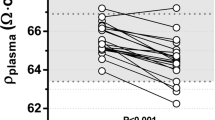Abstract
Haemodialysis (HD) patients are at risk of sarcopenia. Newer bioimpedance devices (BIS) using a three-compartmental body composition model, separate extracellular water overhydration from normo-hydrated lean tissue mass (LTM) and adipose tissue mass (ATM). During HD hydration status changes, along with changes in electrolytes and solutes, and may alter body composition measurements. As such, we measured BIS and serum osmotic pressure (sOP) pre- and post dialysis in 43 patients. There were no significant changes in LTM (39.5±15.1 vs 39.3±15.2 kg) or sOP (33.2±8.3 vs 35.9±9.7 mm Hg). Higher post-dialysis sOP was associated with a greater percentage fall in LTM (r=0.43, P=0.08) and increase in ATM (r=−0.43, P=0.017). Increased sOP post dialysis was associated with a reduction in LTM (r=0.36, P=0.033) and increased ATM (r=−0.44, P=0.013). Changes in sOP with HD are associated with changes in BIS body composition measurements. BIS measurements should preferably be made when patients are least overhydrated.
This is a preview of subscription content, access via your institution
Access options
Subscribe to this journal
Receive 12 print issues and online access
$259.00 per year
only $21.58 per issue
Buy this article
- Purchase on Springer Link
- Instant access to full article PDF
Prices may be subject to local taxes which are calculated during checkout
Similar content being viewed by others
References
Ikizler TA, Cano NJ, Franch H, Fouque D, Himmelfarb J, Kalantar-Zadeh K et al. Prevention and treatment of protein energy wasting in chronic kidney disease patients: a consensus statement by the International Society of Renal Nutrition and Metabolism. Kidney Int 2013; 84: 1096–1107.
Kyle UG, Bosaeus I, De Lorenzo AD, Deurenberg P, Elia M, Gómez JM et alComposition of the ESPEN Working Group. Bioelectrical impedance analysis-part II: utilization in clinical practice. Clin Nutr 2004; 23: 1430–1453.
Fürstenberg A, Davenport A . Comparison of multifrequency bioelectrical impedance analysis and dual-energy X-ray absorptiometry assessments in outpatient haemodialysis patients. Am J Kidney Dis 2011; 57: 123–129.
Panorchan K, Nongnuch A, El-Kateb S, Goodlad C, Davenport A . Changes in muscle and fat mass in haemodialysis patients detected by multifrequency bioelectrical impedance analysis. Eur J Clin Nutr 2015; 69: 1109–1112.
El-Kateb S, Davenport A . Changes in intracellular water following hemodialysis treatment lead to changes in estimates of lean tissue using bioimpedance spectroscopy. Nutr Clin Pract 2016; 31: 375–377.
Chamney PW, Krämer M, Rode C, Kleinekofort W, Wizemann V . A new technique for establishing dry weight in haemodialysis patients via whole body bioimpedance. Kidney Int 2002; 61: 2250–2258.
Tangvoraphonkchai K, Davenport A . Do bioimpedance measurements of over-hydration accurately reflect post-haemodialysis weight changes? Nephron 2016; 133: 247–252.
Montgomery LD, Gerth WA, Montgomery RW, Lew SQ, Klein MM, Stewart JM et al. Monitoring intracellular, interstitial, and intravascular volume changes during fluid management procedures. Med Biol Eng Comput 2013; 51: 1167–1175.
Scharfetter H, Wirnsberger GH, Holzer H, Hutten H . Influence of ionic shifts during dialysis on volume estimations with multifrequency impedance analysis. Med Biol Eng Comput 1997; 35: 96–102.
Thomas BJ, Cornish BH, Ward LC, Jacobs A . Bioimpedance: is it a predictor of true water volume? Ann N Y Acad Sci 1999; 873: 89–93.
Acknowledgements
SE-K was in receipt of a scholarship from the Royal Free Hospital and International Society of Nephrology.
Author information
Authors and Affiliations
Corresponding author
Ethics declarations
Competing interests
The authors declare no conflict of interest.
Disclaimer
None of the data presented has been published in whole or part form.
Rights and permissions
About this article
Cite this article
Antonelou, M., El-Kateb, S., Davies, N. et al. Changes in serum osmotic pressure following haemodialysis treatments lead to changes in bioimpedance spectroscopy estimates of lean and adipose tissue. Eur J Clin Nutr 71, 564–565 (2017). https://doi.org/10.1038/ejcn.2016.270
Received:
Revised:
Accepted:
Published:
Issue Date:
DOI: https://doi.org/10.1038/ejcn.2016.270



